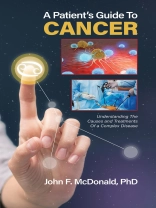A Patient’s Guide to Cancer was written for newly diagnosed cancer patients, their families and friends with the goal of demystifying the processes underlying the disease and explaining how recent discoveries about these processes have and continue to translate into the development of promising new approaches to diagnosis and treatment. While the book is intended to be generally accessible to non-scientists, additional references/links are provided at the end of each chapter for those interested in acquiring nore in-depth coverage of individual topics. Certainly, no one wants to develop cancer, but if you do, it’s important to know that it’s no longer a mandatory death sentence. As a cancer patient, the more you understand about the disease and recent scientific breakthroughs, the more prepared you will be to discuss optimal therapies with your physician(s), and ultimately, make informed decisions about your future life.
Зміст
Preface . . . . . . . . . . . . . . . . . . . . . . . vii
What is cancer? vii
Chapter 1 An Introduction to Molecular Biology . . . . 1
DNA – the blueprint of our body 1
Disruptions in the flow of information in the
cell may occur on multiple levels 3
Our cells are equipped with DNA repair mechanisms
to prevent excessive accumulation of mutations 5
Cancer may be caused by a disrupted flow of
information in addition to mutations 6
Chapter 2 The Molecular Basis of Cancer . . . . . . . . 9
Cancer was initially believed to be caused by
mutations in relatively few genes 9
There are multiple molecular pathways
leading to cancer 10
Chapter 3 Current Approaches to the Treatment of Cancer . . . . . . . . . . 13
Surgery is the oldest and still the
most common treatment for cancer 13
Advanced imaging technologies enhance the
effectiveness of modern cancer surgeries 15
In addition to its role in imaging, radiation can
be used to treat cancers as well 19
Chemotherapy is often an essential complement to surgery
and/or radiation in the treatment of cancer 23
Standard chemotherapeutic drugs work
by killing cancer cells 24
Hormone therapy may slow or stop the growth
of cancers that use hormones to grow 30
Targeted therapies inhibit specific proteins
contributing to cancer onset and progression 32
Immunotherapy enhances the ability of our immune
system to recognize and destroy cancer cells 38
Viruses can be designed to infect and kill cancer cells 44
Summary 45
Chapter 4 Early Cancer Diagnostics . . . . . . . . . . 49
Early cancer diagnosis is important for recurrence
as well as for the onset of the disease 49
Highly accurate cancer diagnostic tests have
both high sensitivity and high specificity 49
The need for diagnostic screening increases as we age 50
Alternative molecular pathways to even the same type of
cancer can reduce the accuracy of diagnostic tests 53
Molecular indicators of cancer may also be
shared by non-cancerous conditions 53
Promising new approaches to early cancer diagnosis
are currently under development 54
Chapter 5 Some Final Thoughts . . . . . . . . . . . . 59
Glossary . . . . . . . . . . . . . . . . . . . . . . . 63












